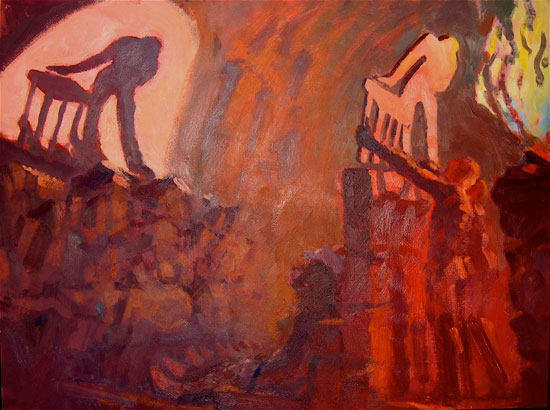
The Tree Makes No Sound
How do you answer the proverbial question: If a tree falls in the forest and no one is there, does it make a sound? I’ll start by posing an answer to the question and then move on to addressing the implications of this answer.
Let’s start with the simplest description of what happens when this weary old tree falls. As it topples the trunk bends then snaps, branches break, it crashes against other trees, leaves rustle slowly at first then faster as the tree slams against whatever else is in its path and eventually the ground. This motion and series of collisions cause vibrations that set the air in corresponding motion. So far is there any sound?
Let’s continue following the chain of events assuming a man named Plato is one hundred yards away out of sight of the tree. Some puffs of air transmitting these complex wave patterns are captured and modified by his outer ear then funneled to his eardrum. Plato’s eardrum vibrates and again alters and transmits the vibrations so they cause the smallest bones in his body, which are located in his ear, to bang against a fluid-filled chamber like some Rube Goldberg machine. The fluid vibrates and causes the sensory cells deep inside Plato’s ear to move. Is there a sound yet? It’s worth noting that if Plato were dead these same things would be happening.
Let’s assume Plato is alive and has a fully functioning brain. The sensory cells dance and transmit a complex neural code deeper within his brain. The signal spreads to other parts of his brain and this code is broken down, analyzed, reconstructed and compared to other events stored in Plato’s memory. Somewhere in this sequence Plato becomes aware of the vibrations that originated “out there.” Somewhere later in this sequence he becomes aware that the code most resembles a pattern that may correspond to the sound of a falling tree. This is the first time I needed to use the word “sound.”
Thus, the vibrations caused by a falling tree only become sound when they are perceived and assigned meaning by a cognizant organism. The falling tree makes no sound. Sound is your interpretation of the cascade of events that began as the tree fell.
Furthermore, the experience of sound can be very idiosyncratic. It can
depend on relatively simple things
like the shape of your ear or the
elasticity of your eardrum. It can also depend on relatively
complex
things like the types of sounds you’ve
experienced in life and your ability to identify
them.
To prove this to yourself compare
your experience
of music to that of an infant.
Or compare your
experience of sound to that of a bat or a piano
tuner
with perfect pitch. If Plato had never before
heard a falling tree it might simply sound like
indecipherable noise akin to
trying to understand
the words of a foreign language.
Why is this important? This
simple example
helps to clearly differentiate between events
that give rise to experience and our experience
of them. The two are different. Our experience
is, in a very real physiological and psychological
way, an interpretation of what we refer to as
external
reality. “Falling tree” is, in a sense, the story we
create to explain the
experience derived from the data
filtered through our senses and interpreted in
our minds
(this discussion could easily be extended to all of our senses and the experiences they afford but that would make for a very long, and way too boring essay.)
Most of our experiences are not this simple. They are much more ambiguous, complicated, amenable to interpretation as well as laden with significance and emotion. All of these things further impact our perceptions. Imagine the implications for how we perceive and interpret more complicated events: Are her eyes blue or green? Why is he looking at me that way? Why did that driver cut me off on the highway? Is she being rude? What were they talking about as I walked by? Does she love me? Is the waiter flirting? Is that a smile or a smirk? Do they really want peace with us? Are they trying to provoke a war?
At this point it should be clear that your perceptions, both simple and complex, are at best an impressionistic and, likely, idiosyncratic interpretation of what’s out there. This offers both challenge and opportunity. The challenge exists because the subjectivity of experience constrains it and limits our ability to appreciate alternate interpretations available to us or adopted by others. Differences between people may lead to unhappiness, conflict or worse. They certainly contribute to much of the discord we encounter as we try to live in harmony with others (and ourselves).
The opportunity, though, can be far greater and empowering. Recognizing the distinction between external reality and our perception of it offers a delineated moment to step back, hold and examine perception as if it were an object in our hands. There is a moment to pause and create a gap after taking in the external information. Within this gap is an opportunity, before we respond, to question, evaluate and adjust our interpretation of the information. More importantly, this affords us the opportunity to adapt how we respond. We can choose to respond intentionally rather than reflexively.
Anais Nin wrote, “We don’t see things as they are, we see them as we are.” This is, perhaps, more true than she imagined.
The practical side of this is that we can truly choose how we interpret and respond to what’s around us. We are built that way because our reality is, by biological design, subjective. This does not imply that “anything goes.” Rather, it means that you possess the autonomy to consider alternate, plausible interpretations not only of the world around you but also of how others are responding to the world around them. It is my hope that this realization will grant you the freedom to actively choose perspectives that create more contentedness and harmony in your life. Why choose anything else?
All content copyright Michael D. Rabin, Ph.D., LLC

